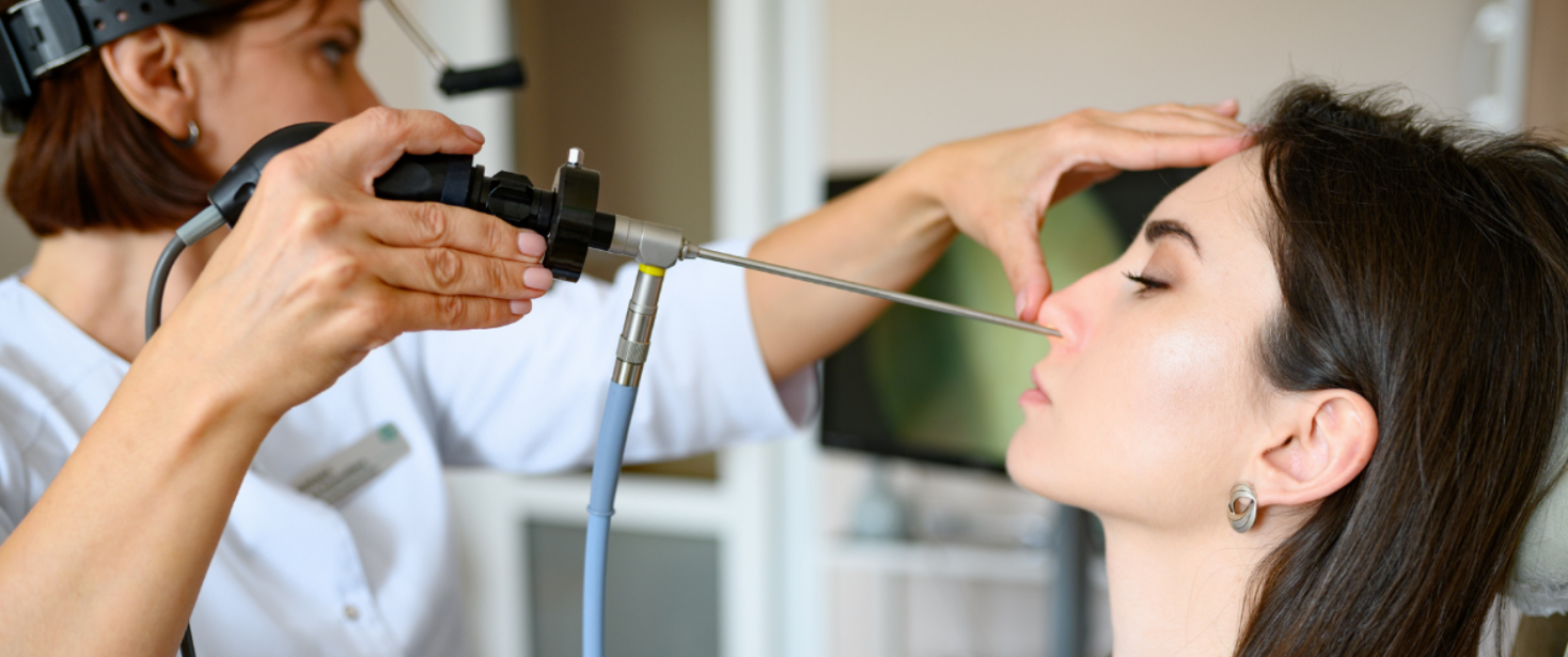What is Nasal Valve Collapse?
Nasal valves, crucial areas within the nose, can sometimes become narrow, leading to breathing difficulties. There are two main types of nasal valves: the “internal” and “external” nasal valves.
- The external nasal valve corresponds to the nostril and is composed of the ala, the round fleshy area on the sides of the nose, supported by cartilages located in the nose tip.
- The internal valve resides inside the nose, between the nasal septum and the lowest section of the upper lateral cartilage, which are cartilages located on the sides of the nose.
Understanding Nasal Valve Issues
Numerous factors can cause nasal congestion and blockage, including a deviated septum, enlargement of nasal tissues (known as inferior turbinate hypertrophy), nasal polyps, allergies, and inadequate support on either side of the nose during inhalation. Ideally, the nasal valves should resist airflow when breathing in. However, weakened cartilages can cause one or both nasal valves to collapse inward, resulting in blockages and nasal congestion.
It’s not uncommon for blockages to be a combination of these factors. Accurate diagnosis and effective treatment options for nasal valve collapse require a comprehensive evaluation by a specialist.
Recognizing the Symptoms of a Collapse
CAUSES OF EXTERNAL NASAL VALVE COLLAPSE
External nasal valve collapse is evident when one or both nostrils partially or completely close when inhaling. On the other hand, internal valve collapse may be less noticeable externally but causes significant narrowing in the upper middle portion of the nose during inhalation. To aid in diagnosis, lifting the skin around the nose or using common aids like “Breathe-Rite” strips can alleviate blockages caused by the internal nasal valve. Additionally, you might observe an upside-down triangle under the nasal bones on the outside of your nose, indicating an “inverted-V deformity,” which is more common after nasal trauma or aggressive nasal surgery.
CAUSES OF INTERNAL NASAL VALVE COLLAPSE
Weakness or an upward orientation of the cartilages in the nasal tip can lead to narrowing of the external valves during inhalation, causing an internal nasal valve collapse. If you’ve undergone previous rhinoplasty, the lower lateral cartilages may have been partially removed, weakening the external valves. Conditions such as widening of the skin and cartilage between the nostrils or a deviated septum into one nostril can also contribute to external valve narrowing.
TREATMENT OPTIONS FOR A COLLAPSED NASAL VALVE
Several treatments can alleviate nasal valve collapse symptoms. Medications, such as nasal steroids like Flonase and antihistamines like Claritin and Zyrtec, may reduce swelling inside the nose and improve breathing. Nasal saline rinses can cleanse the nose and enhance the feeling of openness. Decongestants, like pseudoephedrine, can reduce nasal swelling. For immediate relief, Breathe-Rite strips can open the valves by exerting outward pressure on the nose.
NASAL VALVE REPAIR BY A SPECIALIST
If over-the-counter and prescription medications prove ineffective, nasal valve surgery may be necessary to improve breathing. If you’re experiencing symptoms of Nasal Valve Collapse in NYC and seeking expert care, contact us today to regain the quality of life you deserve.
REPAIR OF NASAL VALVE COLLAPSE IN NEW YORK – CONSULT A SPECIALIST
Nasal Valve Collapse Surgery Before and After


In Need of a Nasal Valve Collapse Surgery?
Learn More About A Collapsed Nasal Cavity
How serious is a valve collapse?
How serious is a valve collapse?
Nasal valve collapse can range in severity from mild to more serious cases. Patients with nasal valve collapse may experience chronic nasal obstruction, which can significantly impact their nasal breathing. The condition can be caused by various factors, including weakened cartilage in the nasal structure or enlarged turbinates. It’s crucial to seek treatment for nasal valve collapse, as it can affect the overall quality of life for individuals with this condition.
What happens if a collapsed nose is left untreated?
What happens if a collapsed nose is left untreated?
Leaving nasal valve collapse untreated can lead to persistent symptoms of nasal obstruction, restricted airflow through the nasal passages, and increased pressure within the nasal cavities. Patients with nasal obstruction may find it challenging to breathe comfortably, affecting their daily activities and overall well-being. Without intervention, the condition may worsen over time, making treatment for nasal valve collapse a critical consideration.
How long does it take for a collapse to heal?
How long does it take for a collapse to heal?
The healing time for a collapsed internal nasal valve can vary depending on the severity of the condition and the chosen treatment approach. While some individuals may experience relief from symptoms relatively quickly, others may require more extensive interventions such as nasal valve repair or cartilage grafting. A patient’s outlook for nasal valve collapse treatment should be discussed with a healthcare professional, taking into account the specific case and treatment plan.
Can you live with a collapsed nasal valve?
Can you live with a collapsed nasal valve?
Patients with nasal valve collapse can continue to live their lives, but the condition can significantly impact their quality of life. Chronic nasal obstruction and breathing difficulties can be challenging to manage on a daily basis. Seeking treatment for nasal valve collapse can help improve nasal airflow and alleviate these symptoms, ultimately enhancing the overall well-being and comfort of individuals with the condition.
How common is nasal valve collapse?
How common is nasal valve collapse?
Nasal valve collapse is not uncommon, and it can affect people of various backgrounds and ages. It may be more prevalent in individuals who have had previous nasal surgery or those with certain nasal structural issues. The condition’s indication often becomes apparent through symptoms such as chronic nasal obstruction, making it essential for patients with nasal valve collapse to explore treatment options, including surgery for nasal valve repair or other appropriate interventions.
Are there different types of collapsed valves, and do they require different treatments?
Are there different types of collapsed valves, and do they require different treatments?
Yes, there are different types of nasal valve collapse, including external and internal collapse. External valve collapse affects the nostrils’ outer portions, often due to weakened cartilage or previous nasal surgery. Internal valve collapse occurs within the nasal structure and can be caused by factors like a deviated septum or enlarged tissues. Treatment of nasal valve collapse varies based on the type and severity of the collapse, with options ranging from non-surgical approaches like nasal valve dilators to surgical interventions like cartilage grafts or plastic surgery.
What role does nasal valve function play in overall nasal airflow and breathing?
What role does nasal valve function play in overall nasal airflow and breathing?
Nasal valve function is pivotal in regulating the flow of air through the nasal airway during inspiration. The nasal valves act as gatekeepers, ensuring efficient and controlled airflow. When functioning correctly, they facilitate comfortable breathing. However, if there’s nasal valve collapse or dysfunction, it can impede the flow of air, leading to symptoms such as chronic nasal obstruction and difficulty breathing.
Is nasal valve collapse linked to previous nasal surgeries or trauma?
Is nasal valve collapse linked to previous nasal surgeries or trauma?
Yes, nasal valve collapse can be linked to previous nasal surgeries or trauma. Procedures like rhinoplasty may involve altering the nasal structure, potentially affecting the nasal valves: nasal valve collapse after rhinoplasty is always a potential complication. Trauma, such as nasal fractures, can also lead to nasal valve issues. Scar tissue formation, changes in cartilage, or weakened nasal structures due to surgery or trauma can contribute to nasal valve collapse.
Can nasal collapse be diagnosed through nasal endoscopy or other tests?
Can nasal collapse be diagnosed through nasal endoscopy or other tests?
Yes, nasal valve collapse can be diagnosed through various tests, including nasal endoscopy. During a nasal endoscopy, a thin tube with a camera is inserted into the nasal passages to visualize the nasal structure. This allows healthcare professionals to assess the nasal valves and determine if collapse is present. Other tests, such as rhinomanometry or prospective studies, may also be used to evaluate nasal valve function and diagnose nasal valve collapse. These diagnostic tools help inform the treatment of nasal valve collapse and the selection of appropriate interventions.

